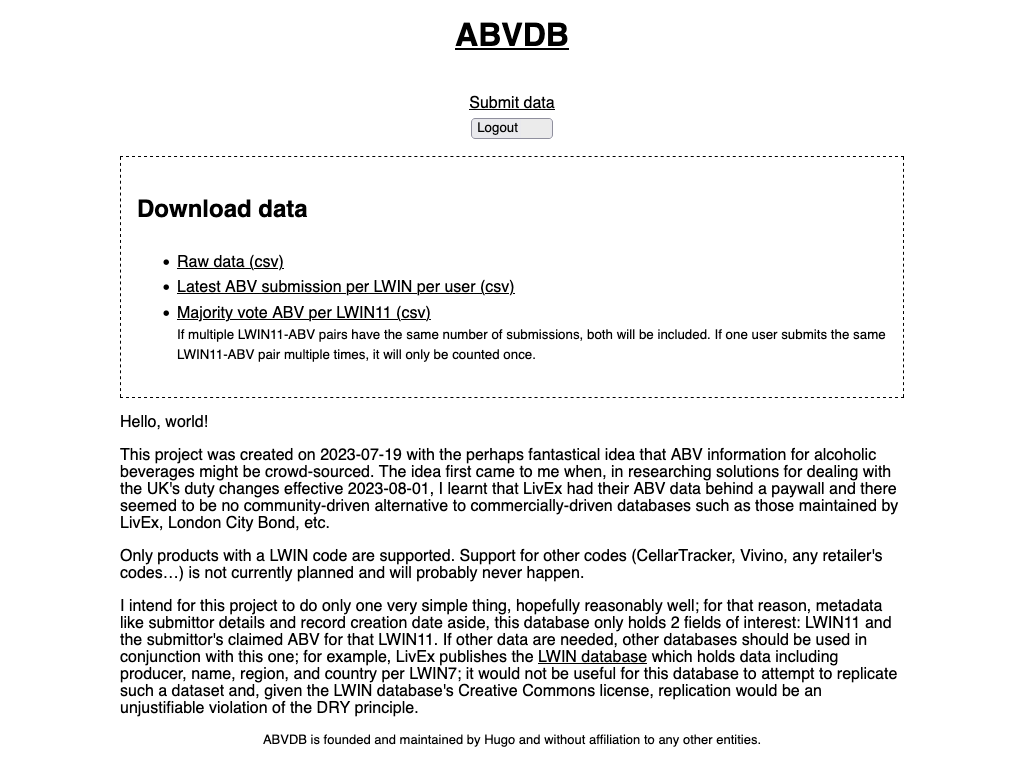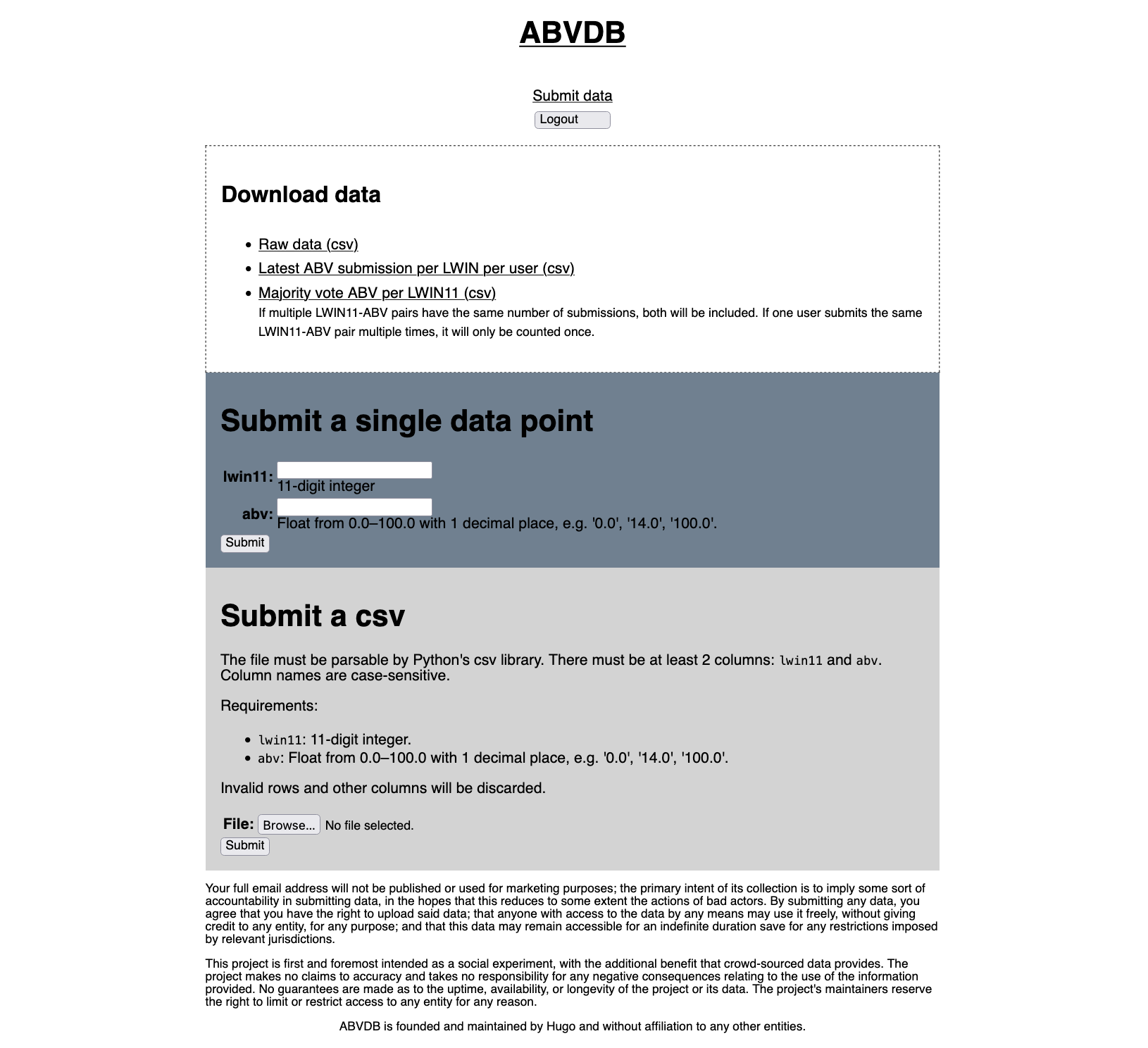- title: "ABVDB"
- date:
ABVDB
Just after midnight today, I made live abvdb.hugopoon.com, the original instance of ABVDB.
It’s funny that, on and off, I spent something like 10 months dabbling with what could arguably have been done in a few hours in Google Sheets, Google Forms, and a handful of =QUERY() formulas.
In fairness, 10 months is really only because Life happened; I had a prototype going after 2 weekends. (As well I should, because there’s really nothing that complicated about ABVDB.)
Motivations
The UK’s alcohol duty changes effective from 2023-08-01, following which the ABV of wine in particular became a more important data point, were the original motivation: over the course of 2023 I got a glimpse of how the UK wine industry was forced to adapt and, from my very limited perspective, it seemed like various people had systems in place — London City Bond had their own ABV data, LivEx had long been compiling metadata as an augmentation of their LWIN initiative, various other trading platforms like Wine Owners had their own database — but it felt like everyone was working on a relatively inward-facing (and often paid) model, a far cry from the FOSS world that I grew up in (with Firefox and Thunderbird being the first projects that I really benefited from, back in the days when Internet Explorer didn’t have tabs).
I should say the non-FOSS approach I saw didn’t really surprise me at all, as the wine industry (at least in the UK context) has always struck me as being astoundingly archaic (for want of a better word) in many ways, particularly as far as interoperability is concerned:
- Hand-typed pricelists sent by email, rather than any kind of structured data (one merchant once told me they did it because it seemed like better presentation — I countered that I’d rather have an ugly spreadsheet with correct, structured data than unstructured data with typos).
- A widespread lack of appreciation for what structured data is (regular expressions are the only way to maintain sanity here).
- Product names with no standardised naming system (is it “appellation, producer” or “producer, appellation”? Why are they even in the same field?)
- Purchase Orders sent by email as PDFs, relying on humans to generate the corresponding Sales Orders.
- Pricing largely done manually.
- Printed pricelists being passed around(‽)
- In my world, those get OCR’d and
tossedrecycled, ideally before I stain the page with wine.
- In my world, those get OCR’d and
Basically, it’s either email or paper, and everything else is a proprietary something-or-other. Well, I guess at least there’s no fax anymore.
Feels like the fragmented standards of computing up until the 1990s(?) combined with, as a consequent necessity to make things work, the secreterial pools of the 1950s.
So even as I entertained the idea of building a Django app and actually launching it, I wondered if crowd-sourcing a database of ABVs would ever be possible. A rather pessimistic view, I know, and I don’t mean it in an arrogant or condescending way or condescending way: it’s just a difference in…lifestyle?
I told myself that, regardless, it would be nice to build something, even if just for the fun of it. Not everything has to be a widely adopted, massively successful “product”.
In fact, part of me hopes it doesn’t blow up in that way, because then I’d have to upgrade the server, lest it blow up.
Anyway, I released the source code under the GPL-3.0 license, though I would be truly amazed if anyone cloned the repo (except with the intention of finding some vulnerability).
Design
I long for the days when links looked like links, buttons looked like buttons, and pages loaded at a decent speed.
I also never understood this shift towards the “sign up” button becoming bigger than the “sign in” button. (When did that happen? In the last 8 years?) Any platform that does that, in my opinion, is showing that increasing user count might be more important to them than their existing users.
Indeed, there currently is no “sign up” button on ABVDB. The reason is simple: I want quality, not quantity, and so am only inviting people I know to contribute for the moment. It may well stay a referral program forever, since I don’t want the hassle that comes with free-for-all registrations:
- Spam
- Adding annoying things like captchas to combat spam (or, worse, Wine-Searcher’s implementation of PerimeterX)
- Running out of disk space because of spam
- Becoming de facto tech support


Data accuracy
ABVDB is really a shockingly simple dataset: LWIN11, claimed LBV, record creation date, and user ID.
So how can we be sure the data is accurate?
We can’t, really. That’s just the nature of crowd-sourcing.
What next?
A rewrite in Rust, of course.
Nothing, really: populate the database and let it be. I don’t really like things that require active maintenance.
Maybe I should blog more. Ever since I stopped using social media, it’s been pretty hard to remind people, with any respectable frequency, that I’m still around.